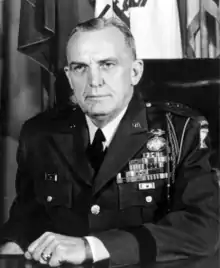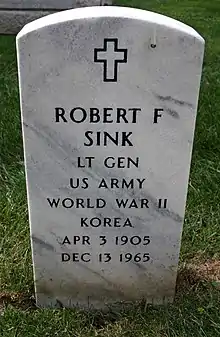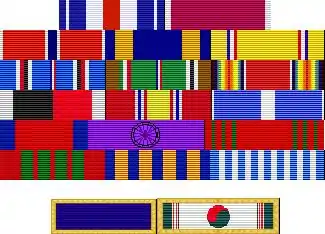Robert Sink
Robert Frederick Sink (April 3, 1905 – December 13, 1965) was a senior United States Army officer who fought during World War II and the Korean War, though he was most famous for his command of the 506th Parachute Infantry Regiment, part of the 101st Airborne Division, throughout most of World War II, in France, Holland and Belgium.
Robert Sink | |
|---|---|
 | |
| Nickname(s) | "Bob", "Five-Oh-Sink" |
| Born | April 3, 1905 Lexington, North Carolina, U.S. |
| Died | December 13, 1965 (aged 60) Fort Bragg, North Carolina, U.S. |
| Buried | |
| Allegiance | United States |
| Service/ | United States Army |
| Years of service | 1927–1961 |
| Rank | Lieutenant General |
| Commands held | Caribbean Command, Panama Canal Zone Strategic Army Corps XVIII Airborne Corps 44th Infantry Division 7th Armored Division 506th Parachute Infantry Regiment 503rd Parachute Infantry Battalion |
| Battles/wars | World War II Korean War |
| Awards | Silver Star (3) Legion of Merit (2) Bronze Star Medal (2) |
Early career
Sink attended Duke University (then known as Trinity College) for one year before securing an appointment to the United States Military Academy. He graduated in the West Point Class of 1927, 174th in a Class of 203 (Cullum Number 8196) and commissioned as an Infantry officer. Sink's initial assignment was to the 8th Infantry Regiment in Fort Screven, Georgia as a second lieutenant.
Sink took assignments in Puerto Rico (1929, 65th Infantry Regiment), at the Army Chemical Warfare School (1932), at Fort Meade (1932), 34th Infantry Regiment, with the Civilian Conservation Corps (1933) at McAlevys Fort, Pennsylvania, and returned to the 34th Infantry Regiment before heading off to attend the United States Army Infantry School at Fort Benning, Georgia (1935).
In November 1937, after assignment to the 57th Infantry Regiment at Fort William McKinley, in the Philippines, Sink returned to the United States and was assigned to the 25th Infantry Regiment at Fort Huachuca, Arizona, where he served successively as company commander and regimental operations officer.
World War II
In 1940, Sink was assigned to the 501st Parachute Infantry Battalion at Fort Benning. He became one of the four percent of the army's paratroopers qualified as a master parachutist and celebrated his birthday each year by making another jump.
Sink later commanded the 503rd Parachute Infantry Battalion and (later) Regiment. In July 1942, he was named as commander of the 506th Parachute Infantry Regiment at Camp Toccoa, Georgia; Fort Benning, Georgia; and Fort Bragg, North Carolina. Sink commanded the 506th throughout World War II, turning down two promotions during the war to remain with the unit.[1] (The regiment was sometimes referred to as the "Five-Oh-Sink".) He became a close personal friend to Major Richard Winters. He made two combat jumps in command of the 506th (D-Day and Operation Market Garden), and commanded the regiment at Bastogne during the Battle of the Bulge.
Postwar career
On August 12, 1945, Sink was named assistant division commander of the 101st Airborne Division. In December 1945, Sink returned to the United States, and the following month assumed command of the infantry detachment of the United States Military Academy. He entered the National War College at Fort Lesley J. McNair in Washington, D.C. in August 1948, graduating in June 1949. Sink then was transferred to the Ryukyus Command, and became chief of staff in October 1949. In January 1951, he was named assistant division commander of the 7th Infantry Division in Korea.
Sink returned to the United States and became assistant division commander of the 11th Airborne Division at Fort Campbell, Kentucky, in December 1951. In February 1953, he assumed command at the 7th Armored Division at Camp Roberts, California. In November 1953, he became commanding general of the 44th Infantry Division at Fort Lewis, Washington. In October 1954, Sink was assigned to the Joint Airborne Troop Board at Fort Bragg, North Carolina. In early 1955, he was transferred to Rio de Janeiro, Brazil, and in April 1955 assumed the dual functions of chairman of the United States Delegation to the Joint Brazil-United States Military Commission and chief of army section, Military Assistance Advisory Group, Brazil.

Sink returned to the United States and assumed command of the XVIII Airborne Corps and Fort Bragg in May 1957. In May 1958, he was announced as commander, Strategic Army Corps (STRAC), United States Army. His last major role was as commander of US forces in Panama (CinC, Caribbean Command, Quarry Heights, Canal Zone).
Sink retired in 1961 as a lieutenant general. He died in December 1965 and was interred in Arlington National Cemetery. Sink was married and had three children.
Awards and decorations

 Combat Infantryman Badge Combat Infantryman Badge |
 Master Parachutist Badge with two combat jump stars Master Parachutist Badge with two combat jump stars |
| Silver Star with two oak leaf clusters | |
| Legion of Merit with oak leaf cluster | |
| Bronze Star Medal with oak leaf cluster | |
| Air Medal with oak leaf cluster | |
| Presidential Unit Citation with oak leaf cluster | |
| American Defense Service Medal | |
| American Campaign Medal | |
| European-African-Middle Eastern Campaign Medal with 3 service stars and arrowhead device | |
| World War II Victory Medal | |
| Army of Occupation Medal with Germany clasp | |
| National Defense Service Medal | |
| Korean Service Medal | |
| Distinguished Service Order (Britain) | |
| Order of Leopold (Belgium), Officer with Palm | |
| WWII War Cross with Palm (Belgium) | |
| WWII War Cross with bronze Palm (France) | |
| Bronze Lion (The Netherlands) | |
| Presidential Unit Citation (Korea) | |
| United Nations Korea Medal | |
 |
Fourragère (Belgium) |
Dates of rank
![]() United States Military Academy cadet – Class of 1927
United States Military Academy cadet – Class of 1927
| Insignia | Rank | Component | Date |
|---|---|---|---|
| Second lieutenant | Regular Army | 14 June 1927 | |
| First lieutenant | Regular Army | 31 August 1933 | |
| Captain | Regular Army | 13 June 1937 | |
| Major | Army of the United States | 31 January 1941 | |
| Lieutenant colonel | Army of the United States | 1 February 1942 | |
| Colonel | Army of the United States | 3 November 1942 | |
| Major general | Army of the United States | 11 April 1948 | |
| Lieutenant general | Army of the United States | 8 September 1959 |
Legacy

- LTC Robert F. Sink Library at Fort Campbell, Kentucky, was dedicated in 1967.[2]
- COL. Robert Sink Memorial Trail up Currahee Mountain in Toccoa, Georgia was dedicated on November 4, 2000.[3]
In popular culture
- The character of "Colonel Robert Stout" in the film A Bridge Too Far (1977), played by Elliott Gould, is based on Sink.
- Robert Sink was portrayed in the HBO/BBC miniseries Band of Brothers (2001) by Vietnam veteran and retired U.S. Marine Corps Captain Dale Dye (also the military advisor on the series).
- Robert Sink was also portrayed in the video game Brothers in Arms: Hell's Highway, also played by Dale Dye.
References
External links
| Military offices | ||
|---|---|---|
| Preceded by Ridgely Gaither |
Commander-in-Chief, United States Caribbean Command 1958–1960 |
Succeeded by Andrew P. O'Meara |
| Preceded by Clark L. Ruffner |
Commanding General, Third United States Army 1960 |
Succeeded by Herbert B. Powell |